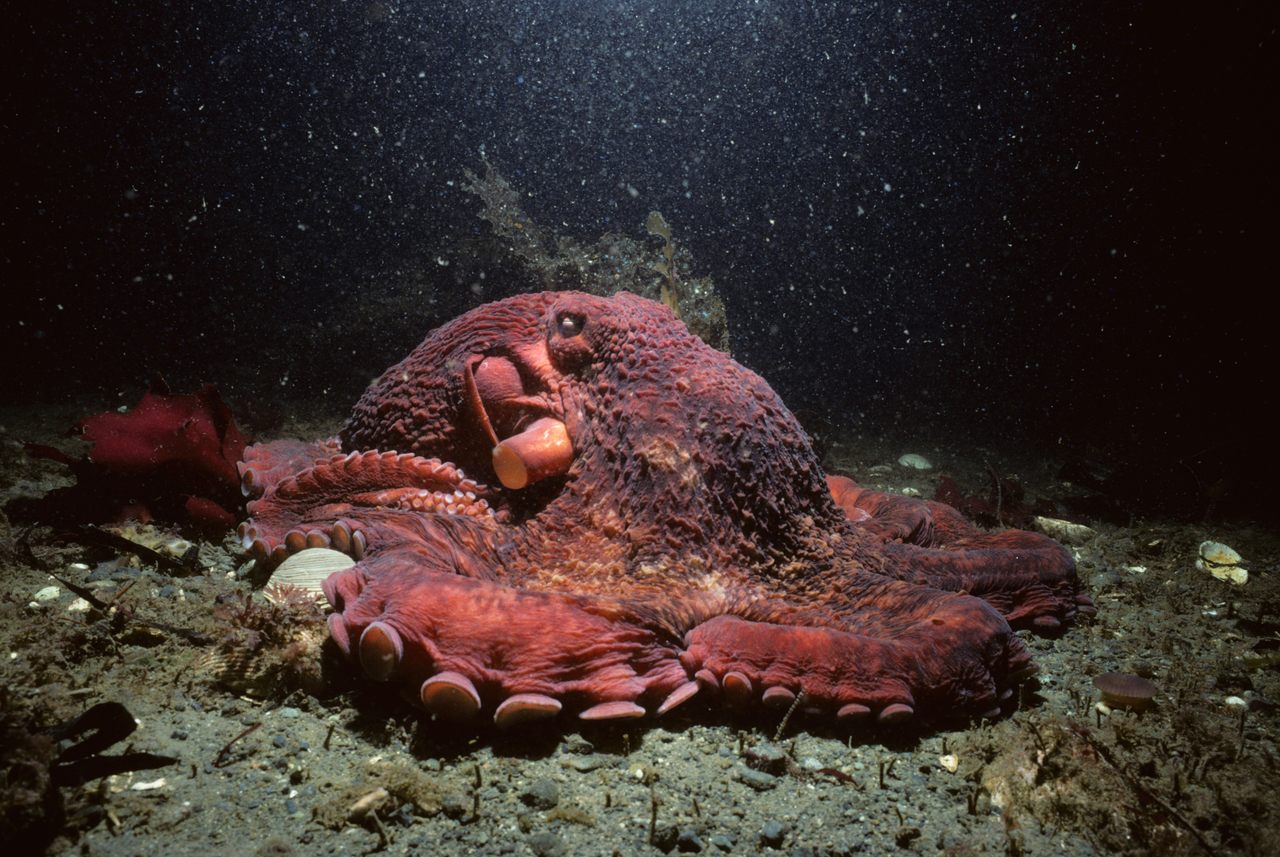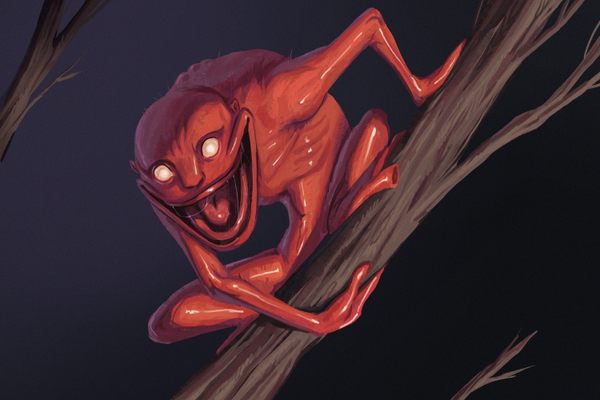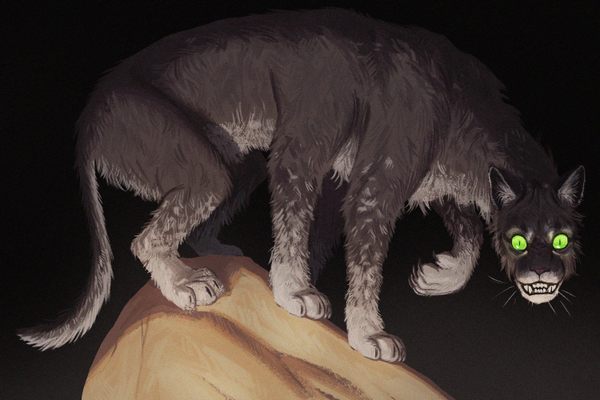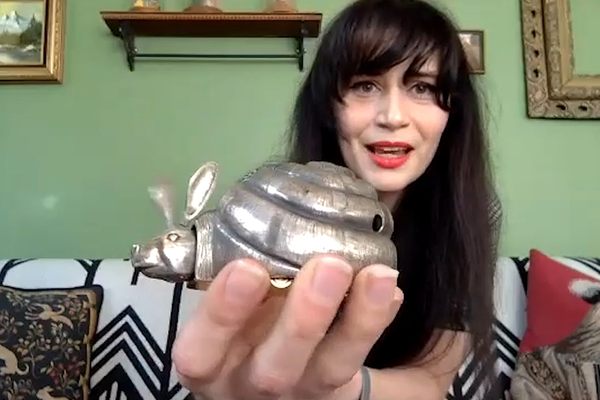How the World’s Largest Octopus Went From Cryptid to Protected
Turns out some monsters are real—and pretty cute.
Sitting on the Pacific coast in northwest Washington State, Tacoma is no stranger to high winds and stormy waters. But in November 1940, the strongest gusts in years twisted the massive Tacoma Narrows Bridge. Steel beams gyrated, the road warped, and, after a final creak, the whole structure collapsed. More eerie than the spontaneous failure was the myth that bubbled up around the disaster—that it was caused not by 40 mph winds but by the meaty arms of a 600-pound, man-eating octopus that still lurks beneath the bridge to this day.
When searching for someone who’s seen the King Octopus, most are surprised it isn’t like other cryptids—people see it all the time. That’s because the King Octopus has a doppelgänger: the giant Pacific octopus. Large specimens can grow up to 600 pounds and 30 feet long, according to National Geographic. Today the legendary cryptid has helped to inspire important protections for its real-world twin.
Stories of Tacoma’s King Octopus spark images reminiscent of the Kraken of Scandinavian folklore. In Old Norse, “krake” referred to an unhealthy animal or something twisted or curled. This evolved to Kraken: the colossal, squid-like creature Vikings supposedly encountered in the waters between Norway and Iceland. These oral tales eventually led to Pierre Denys de Montfront’s iconic depiction of the octopus-like, ship-sinking Kraken in his 1801 book, History of Mollusks.

Coast Salish communities, the original inhabitants of Tacoma, have their own octopus myths, says Connie McCloud, who oversees culture, history, and language departments for the Coast Salish Puyallup Tribe. As home to the world’s largest octopus species, the Puyallup Tribe traded giant Pacific octopuses (Enteroctopus dofleini)—a testament to the animal’s long history and cultural importance in the region.

Local legends tell of octopus shapeshifters, says Michael Sullivan, a Pacific Northwest historian. One story by the Haida tribe in British Columbia even tells of a great octopus chief.
“It’s like reading sci-fi,” he says. “They’re these creatures that shapeshift in and out of human beings. They move through the world and go through the sky. They’re connected with a certain amount of wisdom.” They represent a “curious creature in a changing natural world”—an image that extends beyond Indigenous communities today.
During the early phase of the Tacoma Narrows Bridge construction in 1938, hardhat divers rigged heavy stabilizing cables from the bridge’s towers to massive concrete anchors at depths of 120 feet, says Sullivan. One of the creatures they encountered regularly, as reported to a tender standing on the barge, was the giant Pacific octopus, big ones. Even though the species had been discovered decades earlier, many divers at the time didn’t know about the animal, and so tales of a monstrous “King Octopus” grew.
Divers weren’t exaggerating what they saw, Sullivan says. “You could imagine being in a heavy canvas suit with a cast iron helmet on, and you’re seeing the world through a little porthole in front of your eyes, and in some cases, all of a sudden, you’ve got a big tentacle arm going schloop with suckers left and right,” Sullivan says. “It would freak you out.”

Sensationalist reporting on the “devil fish” by the Seattle Times (then the Seattle Daily Times) didn’t help either, and headlines capitalized on the community’s fears of the man-eating octopus: “700-pound fish of strange shape: odd monster is taken off Gig Harbor,” from October 1907, “Diver is seized by octopus in 85 feet of water,” from March 1913, “Killed by Devil Fish,” from November 1922, and “Octopus drags man to death: Fisherman is pulled by his boat by large devil fish he had speared,” from April 1923.
These elements collided into a sort of man vs. octopus theme, says Sullivan, which came to life in octopus wrestling tournaments on Titlow Beach starting in 1956.
Organized by a Tacoma dive club called the Puget Sound Mud Sharks, three-person teams met at Titlow Beach and plunged into the remains of the Tacoma Narrows Bridge, wrangling an octopus from its den and wrestling it up to the surface to be weighed and released–except for a sorry few that ended up meals.
French naval officer and oceanographer Jacques Cousteau visited Puget Sound the following decade, consulting with members of the Mud Sharks for an episode of his documentary series, The Undersea World of Jacques Cousteau.
In the opening of the January 1972 episode “Octopus, Octopus,” Rod Serling narrated: “This is the giant devil fish—feared and avoided for centuries, subject to fable and folklore—the octopus. Because of its sinister reputation, few have dared to confront this legendary, eight-armed monster of the deep.”

Before Cousteau invented the Aqualung in 1943, the world’s first scuba equipment, and his pioneering documentaries afterward, much of what the world knew about octopuses was speculative.
“Artists and writers long depicted octopuses as gigantic, bloodthirsty creatures powerful enough to crush ships. Dubbed ‘devil fish,’ they were hideous of appearance, ferocious, and hungry,” Serling’s narration continued.
“Octopus, Octopus” goes on to show octopuses are not ferocious, but timid, intelligent, fascinating, and dynamic—bringing the world up to speed on what Coast Salish tribes had long known.
The octopus, with its ability to shift color and texture, to morph its body to fit in nooks, its interaction with the tide cycle, and by extension the moon, became associated with forces of change, McCloud says. Local Indigenous communities respected and revered octopuses, and then in the latter half of the 20th century research started catching up.
Tons of data came out of the Puget Sound on the giant Pacific octopus, such as the 1976 edition of the National Oceanic and Atmospheric Association’s Marine Fisheries Review, quickly putting an end to octopus wrestling and sprouting a love and adoration for the species.

In the following decades, with Tacoma organizations like Communities for a Healthy Bay, this sentiment only grew, says Sullivan. In Tacoma, Kraken-sized giant Pacific octopuses can be seen on t-shirts, ballcaps, buttons, bumper stickers, tattoos, sculptures, statues, murals, and plaques.
“In popular culture, it’s kind of a craze right now. It’s everywhere,” says Sullivan, “but for the Puyallup Tribe and for native people, it’s been part of native art here forever.”
In 2012, a 19-year-old diver harvested a giant Pacific octopus off Alki Seacrest Park in Seattle. He had a license, and giant Pacific octopuses are not endangered. Still, the legal kill sparked enough controversy to launch an online petition that resulted in the cove becoming a Marine Protected Area by law the following year.
Four years later, Titlow Beach, the dive site nearest the Tacoma Narrows Bridge collapse and the former home of the Octopus Wrestling World Championship, followed suit and became a Marine Protected Area for the giant Pacific octopus—a rare accomplishment for a species that isn’t endangered.
Like many once-frightening cryptids (such as Australia’s bunyip or Bigfoot), today the King Octopus isn’t feared but beloved. It and its real-life twin, the giant Pacific octopus, have become unofficial mascots for Tacoma. Divers seek them out, marveling at their size and probing arms, rather than fearing them as they once had.










Follow us on Twitter to get the latest on the world's hidden wonders.
Like us on Facebook to get the latest on the world's hidden wonders.
Follow us on Twitter Like us on Facebook